A Study of the Gold Coast - The Value of Clean Beaches and Waterways
World Tourism
Despite the range and intensity of weather events associated with climate change and other human activities such as wars and terrorism, people are still willing to travel the planet for vacations and recreation and consequently the World tourism industry continues to grow.
The World Tourism Organization (UNWTO) figures for 2018 reveal that international tourism receipts grew to US$1,451 billion, corresponding to an increase in real terms of 4.4% from 2017.
UNWTO encourages the implementation of the Global Code of Ethics for Tourism to maximize the contribution of tourism to socio-economic development, while minimizing its possible negative impacts, and is committed to promoting tourism as an instrument in achieving the United Nations Sustainable Development Goals (SDGs), geared towards eliminating poverty and fostering sustainable development and peace worldwide.
https://en.wikipedia.org/wiki/World_Tourism_rankings
UNWTO's membership includes 158 countries, 6 territories and over 500 affiliate members representing the private sector, educational institutions, tourism associations and local tourism authorities. Its headquarters are in Madrid.
UNWTO reports the following destinations as the top ten tourism earners - income generated from inbound tourism - for the year 2018.
World Rankings
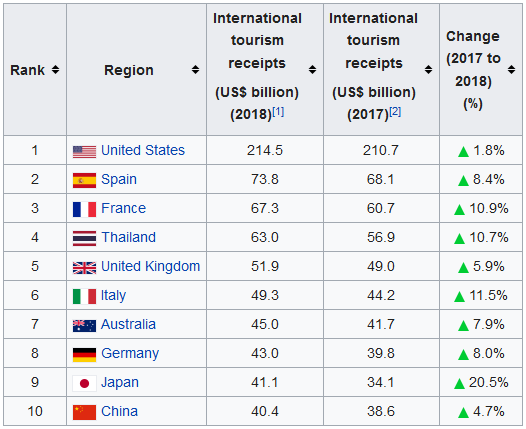
While Australia is not ranked in the World's Top Ten for the number of International tourist arrivals (France is ranked No.1), Australia was ranked Number 7 in the world for international tourism receipts with an increase of 7.9% in international tourism income from 2017 to 2018.
In the Asia-Pacific region, Australia was ranked Number 2 for International tourism income in 2018.
Asia-Pacific Rankings
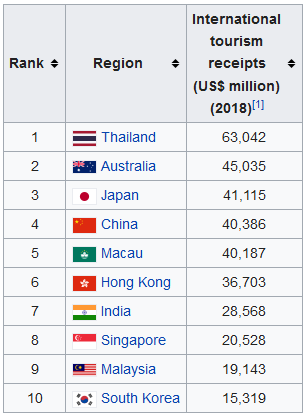
Australia's Most Appealing Tourism Attractions
A recent Tourism Australia survey of over 13,000 international tourists has revealed the 'Most Appealing Australian Attractions' to our international visitors.
At the top of the list are:
"Australian Beaches" at 53% appeal and "Australian Wildlife" at 46%
And at the bottom of the list:
"casinos, nightclubs and bars" at 12% and 'luxury accommodation" at 17%

International Tourist Visits by Country
Currently, the top six countries for International visitors to Australia (Year ending 2018) were:
China, New Zealand, the United States, the United Kingdom, Japan, and Singapore.
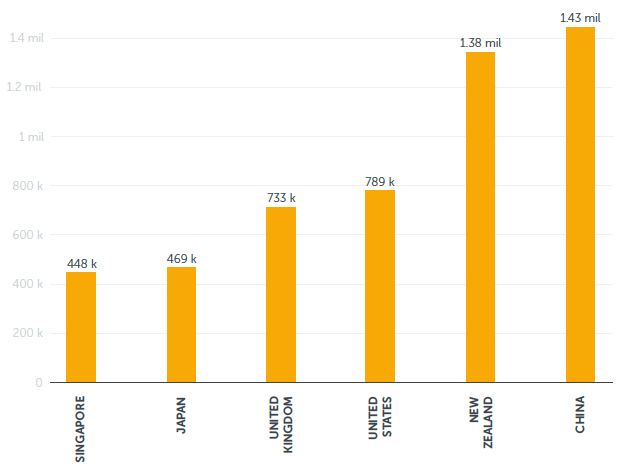
While the total number of visitor nights by International tourists to Australia has risen from 176,589,264 in 2009 to 273,000,000 in 2018, this is the result of the increase in traffic rather than an increase in duration of stay.
https://www.tra.gov.au/International/international-tourism-results
International Tourist Visits by State
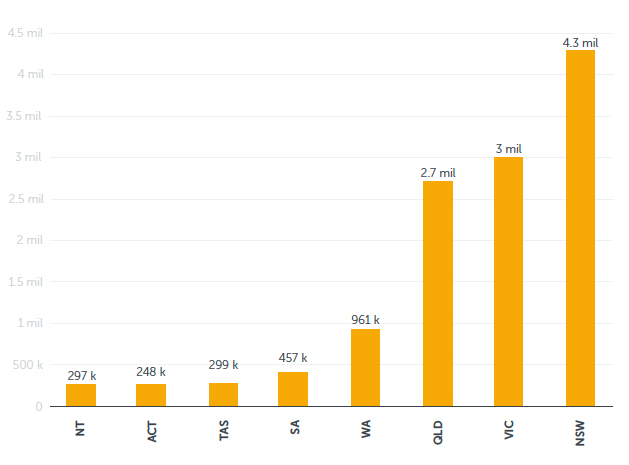
International visitors may travel to multiple States and Territories while in Australia. The top three States for the greatest number of International visitors are:
NSW
The leading State for International tourist in 2018 was NSW with 4.3million visits.
The vast majority of tourists to New South Wales visited Sydney. In 2018, 11.1 million domestic tourists and 4.1 million international tourists visited Sydney.
Victoria
A total of 3 million international tourists visited Victoria in the 2018 calendar year placing it second to NSW.
Melbourne is one of Australia's most popular tourist destinations. In 2018, 10.8 million domestic overnight tourists and 2.9 million international overnight tourists visited Melbourne.
Queensland
There were a total of 2.7 million international visitors to Queensland in the 2018 calendar year, placing it third in Australia for international tourists to a State or Territory.
The total spend in Queensland was $6 billion which accounted for 19.6% of all dollars spent in Australia for the year. International tourists spent a total of 54 million nights in Queensland, which made up 20% of all nights spent in Australia.
Queensland Tourism Appeal
Queensland is the only Australian State to offer all 6 of the most appealing attractions to International visitors as documented in the Tourism Australia 2020 Report survey.
- Australian Beaches (53% appeal)
- The Australian Wildlife (46%)
- The Great Barrier Reef (44%)
- Rainforests/forests and National Parks (42%)
- Unspoilt Natural Wilderness (40%)
- Island Experiences (39%)

More than 26 million domestic and international overnight visitors come to Queensland each year. The Gold Coast region attracts over 13 million of those visitors.
Australia's tourism industry employed 924,600 people directly and indirectly in 2016-17. This accounts for 8 per cent of Australia's total employment at that time.
In 2018, tourism in Australia accounted for 3.1% of the national GDP, contributing $57.3 billion to the Australian economy (an increase of 5.2% over the previous year). This means that tourism GDP grew at a faster rate than the national economy - 26% came from international visitors to Australia while 74% came from domestic tourism.
The data makes it clear that domestic tourism is the economic and jobs driver behind Australia and Queensland's continued tourism success. Therefore, investments in 'attractions' and the marketing of them should reflect the clearly articulated interests of domestic tourists who want family friendly and environmentally-sustainable nature/eco/adventure/wildlife/sports activities while on holiday.
This is in contrast to the Queensland Government's current focus on investing in more casinos and the economically, financially, socially and morally questionable "activities" conducted inside casinos.
The Tourism Australia study into the attractions that most appeal to international tourists visiting Australia reflects the same major interests as domestic tourists; and it is not the "bars, nightclubs and casinos" that are ranked outright lowest of 19 'attractions' in the survey.
Therefore, it is incumbent upon Queensland's Local and State Governments and the Federal Government to put into place appropriate climate change policies; environmentally sustainable practices; and risk management strategies to ensure that Queensland's natural assets (key economic and jobs drivers) are not destroyed or severely negated by direct human actions; environmentally unsustainable commercial or mining activities; or human induced climate change outcomes.
The Gold Coast
The history of the Gold Coast began in prehistoric times with archaeological evidence revealing occupation of the district by Australian Aborigines for at least 23,000 years. The first early European colonizers began arriving in the late 1700s, settlement soon followed throughout the 19th century and in 1959 the town was proclaimed a city.
In the 1930s, a local hotel entrepreneur, Joseph Cavill, pushed to have the local beachfront location's name of "Elston" changed to Surfers' Paradise. The suburb was officially renamed in December 1933 after the local council felt the Surfers Paradise name was more marketable.

The Gold Coast was originally known as the South Coast (being south of Brisbane). Some people agitated for a name that would better reflect the beautiful beaches and the popularity of the area for holidays, e.g. Pacific Paradise, Sun Coast. During the 1950s, the nickname Gold Coast became a popular way to refer to the South Coast area but South Coast locals initially considered the name "Gold Coast" derogatory. However, in October 1958, the Town of South Coast changed its name to Town of Gold Coast. On 16 May 1959, it became City of Gold Coast.
Before European settlement there were several distinct clan estate groups (previously referred to as tribes) living between the Tweed and Logan Rivers and bounded approximately in the west by the town of Beaudesert.
These groups are believed to be the Gugingin, Bullongin, Kombumerri, Minjingbal, Birinburra, Wangerriburra, Mununjali and Migunberri. Collectively they were known as Kombumerri people and spoke the Yugambeh language for which there is evidence of several distinct dialects in the region.
The Kombumerri people were hunters, gatherers and fishers, and are reported to have trained dingos and even dolphins to aid them in the hunting and fishing processes.
The area around present day Bundall, near the Nerang River and Surfers Paradise, along with various other locations in the region, was an established meeting place for tribes visiting from as far away as Grafton and Maryborough. Great corroborees were held there and traces of Aboriginal camps and intact bora rings are still visible in the Gold Coast and Tweed River region today, including the bora ring at the Jebribillum Bora Park at Burleigh Heads.
Captain James Cook was the first recorded European to have 'visited' the Gold Coast when he sailed past on 16 May 1770.
As an explorer under the commission of the Royal Navy, Cook named Mount Warning (a volcanic outcrop 25 kilometres inland) as a natural beacon for a hazardous reef off the mouth of the Tweed River near a rocky outcrop he named, Point Danger.
Captain Matthew Flinders, an explorer charting the continent to the north of the colony of New South Wales, sailed past the Gold Coast in 1802 but the region remained uninhabited by Europeans until 1823 when explorer John Oxley landed at Mermaid Beach, named after his boat, a cutter called Mermaid.
Despite the early appearance on colonial maps, it wasn't until New South Wales government surveyors charted the region in 1840 that the area was really brought to the attention of European settlers.
(adapted from https://www.goldcoast.qld.gov.au/thegoldcoast/gold-coast-histories-26556.html)
Gold Coast Beaches and Waterways
The Gold Coast is now renowned for its white sand beaches that stretch 57 kilometres (35 miles) down the coastline fronting the Pacific Ocean to the NSW state border.
The Gold Coast's network of waterways now consists of five main rivers, numerous creeks, lakes, canals and the Nerang River estuary known as the Broadwater. 480 kilometres of rivers and streams, as well as 774 hectares of lakes, dams and canals, wind their way through the city's landscape to the city's Pacific Ocean beaches.
The largest of the city's rivers flow into southern Moreton Bay - these rivers include the Albert, Logan, Coomera and the Nerang. At the southern end of the Gold Coast, the catchments of Tallebudgera and Currumbin, and the smaller Flat Rock and Coolangatta Creeks, flow directly into the Pacific Ocean.
The Gold Coast is host to 446 km of canals that were man-made during the 1960s and are 9 times the length of the canals of Venice, Italy. The canals form an environmentally significant network of waterways and host a large number of marine species and bird life.
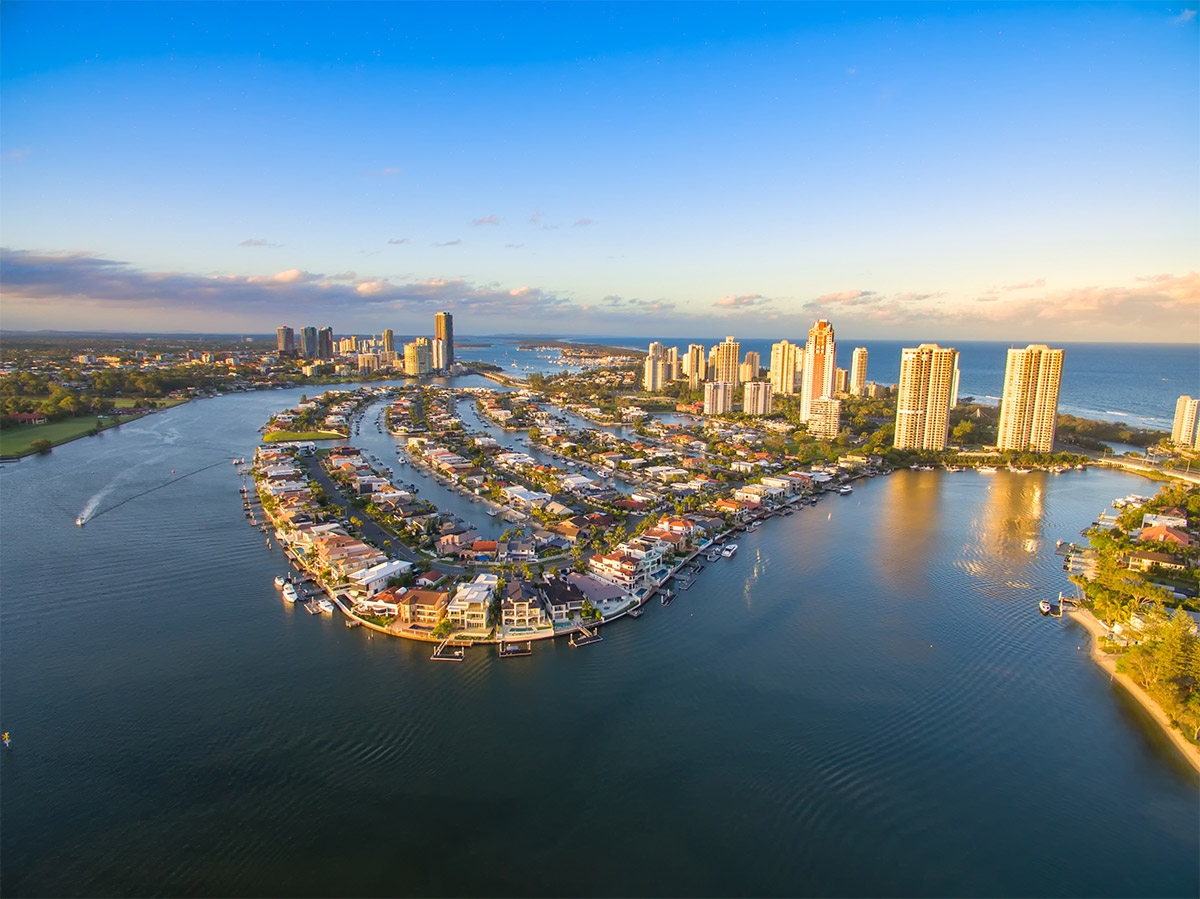
Natural events that affect the climate, air, weather and tides, as well as human impacts such as nutrients, pollutants and recreational use, can impact the health of waterways.
Other water environments on the Gold Coast include wetlands, groundwater sources and estuaries.
Keeping the waterways in good condition also assists their vitally important role as buffers against flooding, helping to reduce the impacts of major floods on surrounding and downstream areas. The volume of stormwater received is directly related to increases in water levels and any major flooding. This includes run off from roads, gardens and roofs which is often untreated.
Clean and healthy waters are vital for the Gold Coast's environment which is the home to complex eco-systems; the lifestyles of residents; local jobs and the economy; and recreational and tourism activities reliant on water-based activities such as swimming, boating, surfing, fishing, diving and sailing.
The Gold Coast Spit
A spit is an extended stretch of beach material that projects out to sea and is joined to the mainland at one end. Spits are formed where the prevailing wind blows at an angle to the coastline, resulting in longshore drift of sand. This process often occurs where a river mouth meets the sea.
The Gold Coast Spit has been present as a natural form since at least the 1800's. It gradually moved in a northerly direction as the Nerang River silted up and then burst free to the ocean again.
In the early 1800s the Nerang River entered the Pacific Ocean where the 'The Star Gold Coast Casino' is located in Broadbeach. In 1930 the entrance was where Seaworld theme park now stands on The Spit.
Reports of the Gold Coast Spit growing rapidly in a northerly direction date back to the years 1897-1898 when it was reported that a series of gales and high seas finally broke through a narrow stretch of land called Jumpinpin on Stradbroke Island, causing the one island to separate into two islands, now known as North and South Stradbroke islands.
An alternative explanation is that local mariners used explosives to blow up and breakthrough the Jumpinpin land to create a new sea passage into Moreton Bay. What is known is that the change in hydro-dynamics, caused by the breaching of Jumpinpin, speeded up the process of The Spit growing in a northerly direction.
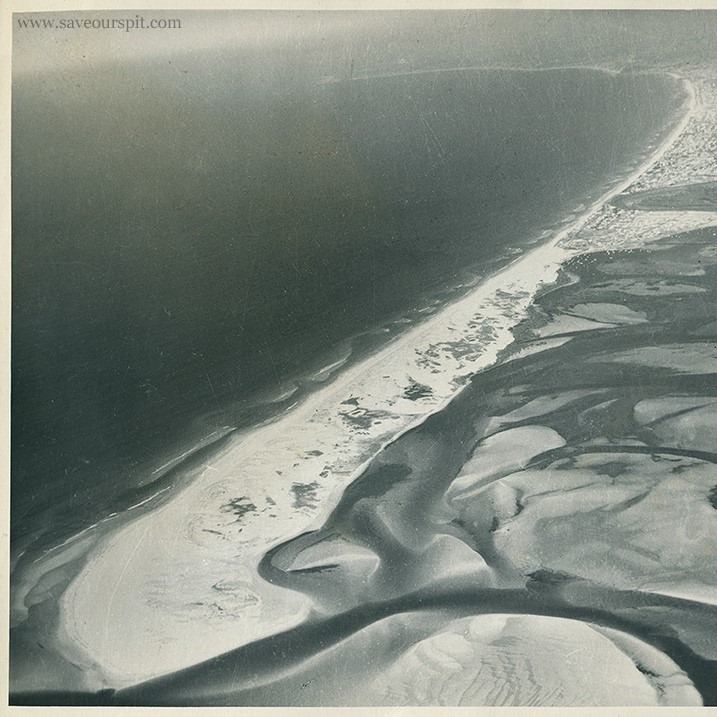
Over time the Nerang River mouth moved northward by up to 60 metres each year, causing land erosion and changing sandbanks at the bar and adjoining Broadwater.
Predominant south-easterly winds, the significant northern drift of sand and wave climate combines to move an estimated 500,000 cubic metres of sand along the Gold Coast and south-east Queensland coast each year.
It was estimated that by 2050, the Nerang River entrance would be opposite the northern Broadwater suburb of Runaway Bay if no action was taken, and the township of Currigee on South Stradbroke Island would be in danger.
It was already too late for Moondarewa, a coastal town near where Seaworld is located today. It was lost into the sea in the late 1930s during storms as the Nerang River entrance migrated northwards.
The Nerang River Estuary on the leeward side of The Spit is known as The Broadwater.
The Gold Coast Seaway
Prior to the construction of the Gold Coast Seaway in 1986, the northerly migration of the Nerang River entrance to the Pacific Ocean (locally known as the Southport Bar) had a history of instability.
Research revealed that with the magnitude of the northward drift of sand along the coastline, any scheme to stabilise the entrance would require a commitment to artificially bypass sand across the river mouth in perpetuity.
The Delft Hydraulics Laboratory of Holland, had previously researched and reported on the beach erosion problems on the Gold Coast. In 1976 they presented a report to the Queensland Government which established a number of parameters which would be used in the final design of the scheme.
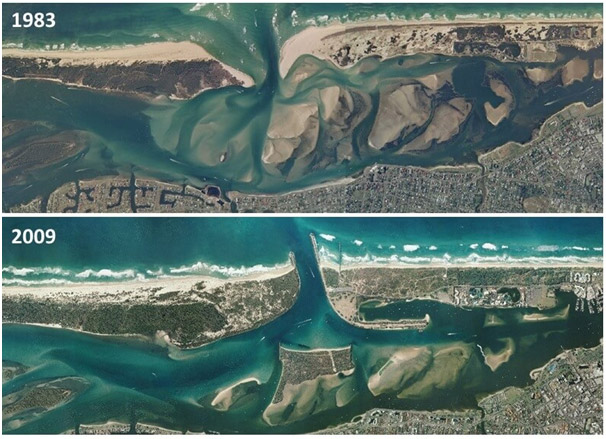
In the late 1970s, the Queensland Government conducted intensive research into the possible solutions and in 1983, the Queensland Government took action to stabilise the river mouth.
It was clear that the most economical approach would be to construct two breakwaters to form a new entrance through the Spit, just south of the existing entrance. Model studies at this time aided the design of these walls to ensure they would be capable of withstanding the cyclonic conditions that may be encountered.
It was also shown that orientation of the breakwaters to 15 degrees north of east and increasing the length of the southern wall would reduce the entry of ocean swells. Other model studies investigated the effects of wave penetration into the Broadwater. From this evolved the need to construct Wave Break Island, to capture storm waves and protect the western foreshore of the Broadwater.
A number of methods were then evaluated to bypass sand across the entrance. No comparable system existed elsewhere in the world. The system finally selected involved pumping sand trapped by the southern wall through a pipeline under the seaway to discharge onto the ocean beach at South Stradbroke Island.
The Sand Bypass System was designed to mimic the natural flow of sand along the coast line and minimise impacts to the coastal environment.
At the jetty, sand is drawn in by submerged jet pumps along the jetty pylons; this northwards drifting ocean sand is intercepted before it accumulates at the Nerang River entrance. ... The sand is then piped to the landward end of the jetty and 'delivered' through underground pipes back to the ocean north of the river onto the beach on South Stradbroke Island.
The large-capacity fixed-sand bypassing system is an integral part of the design of the seaway and currently pumps 500,000 cubic metres of sand across the Seaway each year.
Today, the Gold Coast Seaway facilitates safe transit between the Broadwater and the ocean for recreational and commercial vessels. The sand bypassing system, ongoing dredging and construction of Wave Break Island have ensured that the entrance to the Broadwater was stabilised without detriment to surrounding beaches. The Gold Coast Seaway is an unqualified success proving that although nature can't be tamed, she can be guided.
(adapted from https://gcwa.qld.gov.au/gold-coast-seaway-history/)
Economic, Environmental and Tourism Values
In 2012, a major study by Urbis revealed the economic values associated with a healthy and functioning Broadwater and its foreshores. The Economic Baseline value of the Gold Coast Broadwater in 2012 was almost $4.16 billion.
This value included:
Residential and Non Residential Property Values; Marina Values; Open Space Value; Environmental land value; Infrastructure Values; and Waste Water Treatment.
Open Space was valued at $818.34 million and Environmental land at $1.56 billion for a combined total of $2.38 billion; that is, more than half the Broadwater's value rests in its open space and environmental land.
And the Urbis study does not include the value of the open space and environmental land on the ocean side of The Spit – Philip Park and Federation Walk Coastal Reserve (93 hectares).
Federation Walk Coastal Reserve coastal supports a subtle mix of habitats including littoral rainforest, native grasslands, pockets of wetlands and hosts the last remaining full coastal dune system (3.5 kms in length) on the Gold Coast. The ocean-side of The Spit offers consistent world-class surf breaks.
The network of trails through the reserve is used for bushwalking, birdwatching, running and bike riding and a leash-free dog beach is available at the most northern end of The Spit.
Furthermore, in 2012 it was estimated that the Broadwater sustained 2,500 FTE direct jobs. Dependence on the Broadwater for Commercial employment on The Spit is at 100% dependency, Retail 98% and Service employment 99%. The Gold Coast Broadwater is an important asset for Queensland and particularly the Gold Coast, forming a key part of the region's brand and image. It is an attractor for residents, visitors, tourists, commercial activities, and an important part of the region's ecological footprint.

The Broadwater and Seaway offer opportunities for sailing, boating, fishing, swimming, snorkelling, kite & windsurfing, kayaking and the best inshore dive sites of any city in Australia.
Surfing
The Australian Bureau of Statistics reports that participation in surfing is second only to swimming; slightly higher than fishing; and greater than ice and snow sports; waterskiing and power boating; sailing; canoeing and kayaking; scuba diving; and surf lifesaving, in that order.
Surfing activity can be found all along the Gold Coast's 57 kilometres of ocean beaches. There is a clustering of surf businesses from Burleigh Heads to Coolangatta. World famous surf breaks can be found at both ends of the Gold Coast including the "Superbank" at Coolangatta. This southern section of the coastline from Burleigh Point to Snapper Rocks was declared a World Surfing Reserve in 2015.
The Gold Coast joins a small honour roll of other renowned World Surfing Reserves including:
- Malibu, California
- Ericeira, Portugal
- Manly Beach, Australia
- Santa Cruz, California
- Huanchaco, Peru
- Bahia Todos Santos, Baja California Mexico
International professional surfing events on the Gold Coast, such as the Quiksilver and Roxy Pros, provide international exposure with millions of people around the globe viewing the event over webcasts.
(Gold Coast City Council. Source: Surf Industry Review and Economic Contributions Assessment, Aug 2009)
A 2017 study estimated the worldwide value of good surfing waves to be $50 billion per year. Surfing represents a very profitable market, a growing industry, and a reason people move to coastal areas. Surfing plays a major part in the recreation and tourism strategies for many coastal locations. Any negative impact to the surfing amenity in these locations may have serious consequences for the resident surfing population, visitors to the area, the local surf industry and the entire local coastal economy.
A recent Surf Industry Development Report, which was a world first, found $2 billion in activity was attributable to the surfing industry on the Gold Coast, making it the city's third biggest industry.
The industry is incredibly diverse including surfboard shaping, clothing and hardware design, surf schools, educators and surf media. In addition to recreational surf tourists, surfing events such as the Quiksilver and Roxy Pros and surf schools (https://getwetsurf.com/ ) generate significant tourism spending.
The report estimated the sport generated up to a further $3 billion in output and created 21,760 employment positions paying $1 billion per annum in wages and salaries.
http://www.beachapedia.org/Surfonomics
In 2008, socio-economic study of recreational surfing on the Gold Coast, Queensland was prepared as part of the Gold Coast City Council Shoreline Management Plan by Neil Lazarow through Griffith University's Centre for Coastal Management Research.
A summary of the 2008 study revealed:
- A conservative estimate of the number of recreational surfers on the Gold Coast was 65,000, made up of 41,000 resident surfers and 24,000 visiting surfers. The upper estimate is approximately 120,000 surfers.
- It is estimated that there are between 6 - 15 million person visits or individual surf sessions per year on the Gold Coast.
- The total reported annual expenditure by recreational surfers on the Gold Coast was estimated to range from $256 - $474 million.
- A more conservative approach filtered the data in order to account for expenditure that was likely to take place outside of the Gold Coast. Using this method the total reported annual expenditure by recreational surfers on the Gold Coast was estimated to range from $126 – $233 million.
- These figures treat visitation and expenditure by local residents and visitors (day, short-stay, long-stay and semi-permanent) in the same manner, do not account for the value of surf schools, airline travel to the Gold Coast, accommodation taken up by visitors who surf or surf industry related values such as rent and the wages of those involved in the surf industry. Each of these factors may substantially increase the total worth of surfing to the region.

Here is an example of the estimated expenditure value of recreational surfing at 4 of the 9 Gold Coast study locations, per year by Location (percentage of total) and Expenditure value (to the nearest million) in 2008:
Main Beach / Southport (3%) $3.5 – 7 million
Narrowneck (3%) $3.5 – 7 million
South Stradbroke Island (14.5%) $18 – 33 million
Spit (6%) $7.5 – 15 million
Total (26.5%) $32.5 – 62 million
In 2008, over one-quarter of annual expenditure by recreational surfers on the Gold Coast was spent in the four northern-most ocean beach locations adjoining The Spit and Broadwater.
The total (conservative) annual expenditure by recreational surfers for all Gold Coast beaches was $126 – 233 million.
http://www.valueofwaves.org/uploads/1/1/4/2/11420190/lazarow_2008_final_report_socioeconomic_study_of_recreational_surfing_on_the_gold_coast_lowres.pdf
Extrapolated to 2019 figures, a conservative estimate of the contribution to the Gold Coast economy by resident and visiting surfers, based on inflation and surf population growth, is $186 – 335 million per annum.
Boating and Fishing
With nine times more waterways than Venice, the Gold Coast is a boating paradise with over 260 kilometres of navigable waterways within the city; 480 kilometres of rivers and streams and 890 kilometres of constructed residential waterfront land within the city.
Fishing
Almost 943,000 Queenslanders went recreational fishing in Queensland in 2019.
Recreational fishing's popularity has increased amongst Queensland residents 5 years or older from 15% in 2013 to nearly 19% in 2019. Most of Queensland's regions had increasing participation rates, particularly the Gold Coast which increased from 8.8% in 2013 to 13.3% in 2019, a change of 51%.
https://www.daf.qld.gov.au/business-priorities/fisheries/monitoring-compliance/monitoring-reporting/recreational-fishing/statewide-recreational-fishing-surveys
The Gold Coast seaway offers convenient access to the Pacific Ocean for those interested in deep-sea fishing. Boat and other watercraft owners can also access good fishing in the Seaway, Broadwater and Gold Coast rivers and streams.
Surf fishing from the beach is available along the 57 kilometres of Gold Coast beaches.
The Gold Coast Sand Pumping Jetty on the northern end of The Spit is a popular destination for fishers and likewise the southern Seaway Wall for those who do not own watercraft. Also the GCCC has provided fishing platforms at various locations throughout the Gold Coast waterways.
https://www.goldcoast.qld.gov.au/thegoldcoast/fishing-locations-by-suburb-3080.html
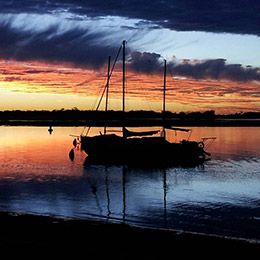
Boating
The Gold Coast has one of the largest boating communities in Australia. There are more than 40,000 registered watercraft in the city, which boasts the highest mixed use of watercraft of any Queensland centre.
Although boats and marine craft are made to withstand salt water and the Gold Coast sunshine, their exteriors require regular cleaning and conditioning to maintain their looks and function. Mark and Michael from www.gcsailingcharters.com.au use their years of boating experience to offer boat charters to Wavebreak Island and behond. This is an example of the many jobs created directly from our waterways.
Also 250 hectares of land alongside the Coomera River to the city's north was dedicated to the marine industry through a special Act of State Parliament. The Gold Coast Marine Precinct is the major marine industry area dedicated to manufacturing, servicing, repairs and refits of recreational and commercial vessels.
The precinct area holds the heaviest concentration of boat builders and marine-based industries in Australia – about 80 per cent of all boats built in the country - and supports two and a half thousand jobs.
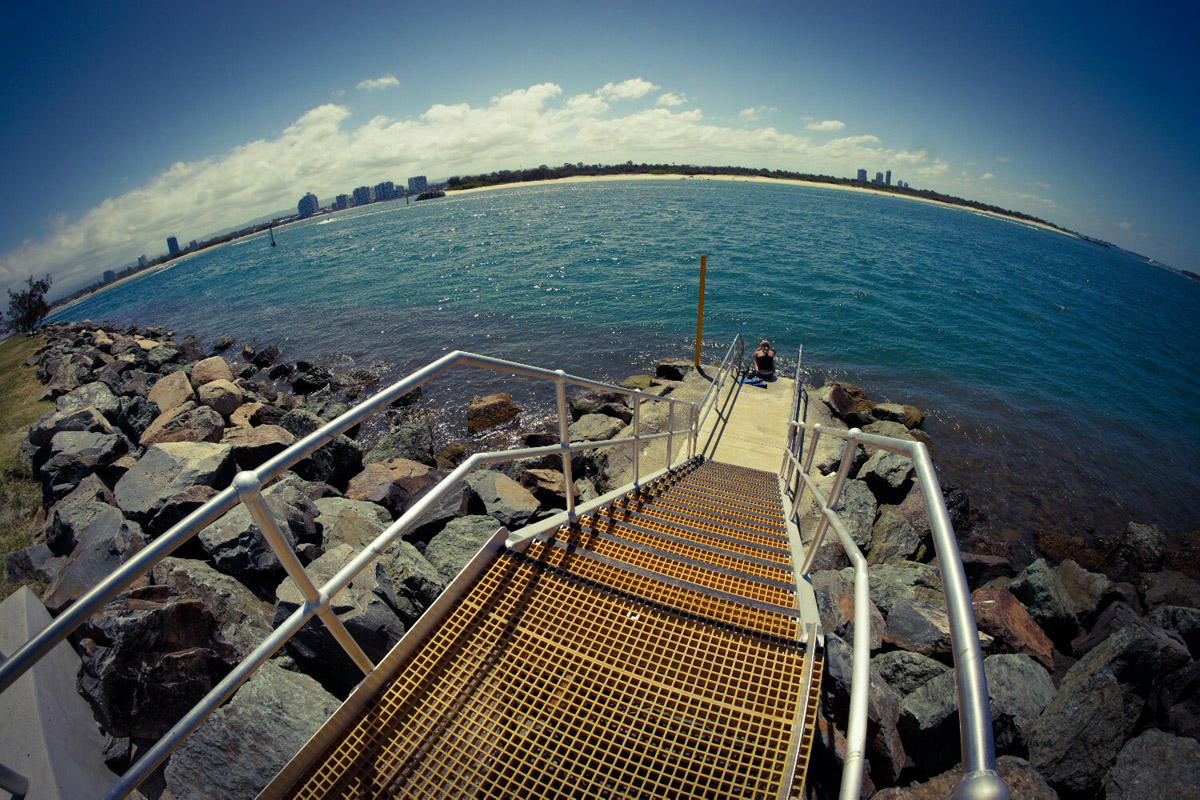
Diving
There are approximately 1.2 million diving trips and 2.3 million snorkelling trips undertaken in Queensland each year, with approximately half undertaken by overseas visitors.
Queensland's recreational diving and snorkelling sector contributes approximately $1.4 billion to the Queensland economy every year and it is a major driver in the state's tourism sector.
The Gold Coast's recreational and tourism dive industry was estimated back in 2006 to have brought $200 million in local expenditure for the year.
https://www.worksafe.qld.gov.au/__data/assets/pdf_file/0004/82516/dive-reference-group-report.pdf
Offshore
The Scottish Prince, 800 metres off the Gold Coast's Southport Spit, features the wreck of a three steel-masted, 64 metre iron barque ship. The Scottish Prince sank as it was sailing from Glasgow, Scotland to Brisbane with a cargo of whiskey, mousetraps, linen and other assorted cargo on 3 February 1887.
The Scottish Prince is covered in soft corals and sponges, making it a haven for crayfish, shovelnose rays, brown-banded cat-sharks and wobbegong sharks, and other tropical fish. The Scottish Prince is protected under the Commonwealth Historic Shipwreck Act. The Scottish Prince attracts many boats early, picking up bait fish for their venture further outside in search of Snapper or other species.
Also a purpose-built reef dive attraction is proposed for 3.5 kilometres south-east of the seaway and 2.5 kilometres offshore from Philip Park, Main Beach, at a depth of 30 metres. It will be less than 20 minutes from dock to dive and will provide at least three return dive charters per day. With an average of 220 diving days per year. The dive attraction is being delivered under joint funding by the City and the Queensland Government. The dive attraction will inject an estimated $32.8 million into the region's economy through the generation of an estimate of more than 160,000 new overnight visitors to the Gold Coast with the specific intention of diving and/or snorkelling.
Inshore
The Gold Coast or "Southport" Seaway has the reputation as "the best inshore dive site of any Australian city."
Over 540 species of marine life have been documented and categorised by the Queensland Museum as inhabiting the Seaway and the waters to the eastern shores of Wavebreak Island.
The Southport Seaway area mainly consists of current swept clean sandy substrate to a maximum depth of 20 m, bordered by steep rock walls constructed of large boulders. There are some relatively sparse seagrass beds in the western portion. The area also features several extensive submerged pipelines which consistently attract large aggregations of fishes.
While much of the habit in the seaway is comprised of man-made structures, the area was included separately as a site for this study as it supports very significant fish communities, elements of which are rarely found elsewhere in the region, e.g. aggregations of White-spotted guitar fish (Rhynchobatus laevis), Whip rays (Himant ura fai and H. uarnak), Ghost-pipe fishes (Soleno stomus cyanopterus and S. paradoxus) Pipefish (Stigmato phora nigra and Trachyrhamphus bicoarct atus), High-crown seahorse (Hippocampus procerus) and Queensland Groper (Epinephelus lanceolatus).
https://www.researchgate.net/publication/285748763_Fishes_of_the_Moreton_Bay_Marine_Park_and_adjacent_continental_shelf_waters_Queensland_Australia
Since 1986, the Gold Coast Community has fought against several proposals for the construction of cruise ship ports in the Seaway, Broadwater or off The Spit.
refer Premier (Beattie) sinking Gold Coast dive industry
refer Spitfighters Fight Back - Life Weekly article
The tourism and recreational dive industry and dive schools operating out of the Seaway bring far greater economic, job and tourism benefits to the Gold Coast (without destroying the existing marine environment) than any perceived benefits of a commercial cruise port that would by necessity destroy the current dive industry and marine ecology in the Seaway, Broadwater and in the ocean off The Spit beaches where the heritage protected Scottish Prince wreck is resting.
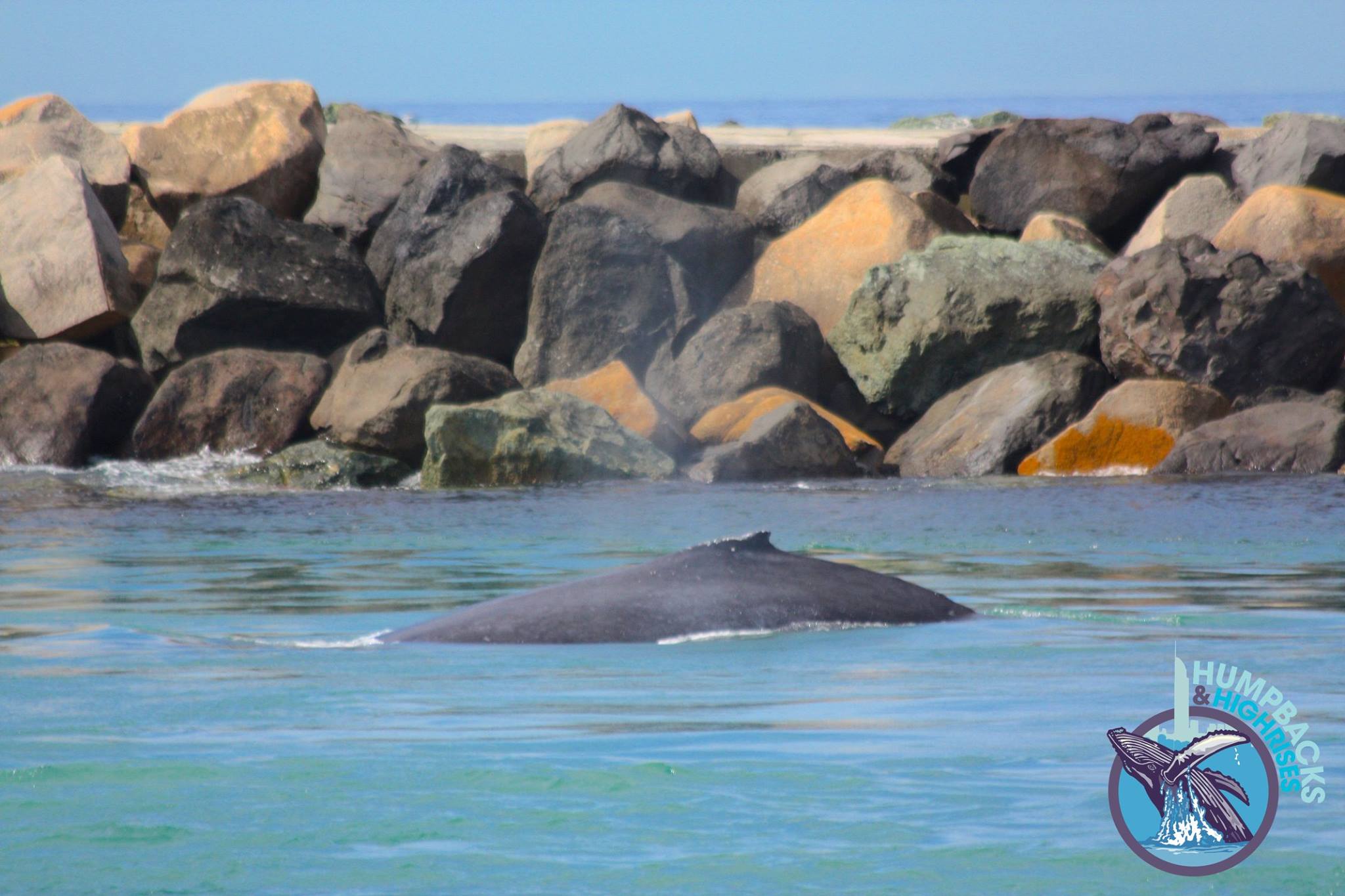
Bird and Whale Watching
Birds
The Broadwater is the summer home to about 400 migratory waders. The three main species are Eastern Curlews, Whimbrels and Bar-tailed Godwits. While some remain on the Broadwater during winter, most take part in one of the great feats of nature. During March and April they leave here on their annual migration to northern polar lands such as Siberia and Alaska where they breed. They return to Australia in August and September, having completed a round journey of between 16,000 and 20,000 kilometres.
The Federation Walk Coastal Reserve's vegetation communities consist of small patches of coastal woodland and large areas of heath, just like a piece of original Queensland's Moreton Bay before European colonisation. The bird life is different to what you may find in the suburban Gold Coast.
A stroll along the Federation Walk is a fresh experience for tourists who are able to find many iconic Australian Birds. The benefit of this reserve is felt way beyond its boundaries. It is a safe home from which birds are able to forage in other parts of the city. The once rare Bush Stone Curlew is now a common site in the evening around the Broadwater. However, when day breaks some return to the Spit haven for their day camp.
(Robert (Bob) Westerman. Birds of The Broadwater and The Spit – Gold Coast, Australia. Wildlife Preservation Society of Queensland, 2014)
http://www.saveourspit.com/No_Terminal/resources/Broadwater-Birds.pdf
Birdwatching can be a very effective type of ecotourism. In general, the criteria for a tourism activity to qualify as 'ecotourism' are; minimal negative impacts on the social and natural environment, maximum benefit for local communities as well as positive conservation, education and economic effects.
By visiting locally owned businesses for meals and beverages (including day trippers); engaging the services of a local guide; and staying in local accommodation, birdwatchers can deliver financial benefits to local communities and local economies.
https://www.wildlifetourism.org.au/a-focus-on-gold-coast-birdwatching/
Whales
The number of whales swimming up and down the coast between Antarctica and Queensland has tripled to 30,000 since a whaling ban in 1979, turning us into a nation of whale-watching fanatics. Now tourists are flooding to join us.
https://www.traveller.com.au/soaring-numbers-point-to-a-whaleled-tourism-recovery-gy72di
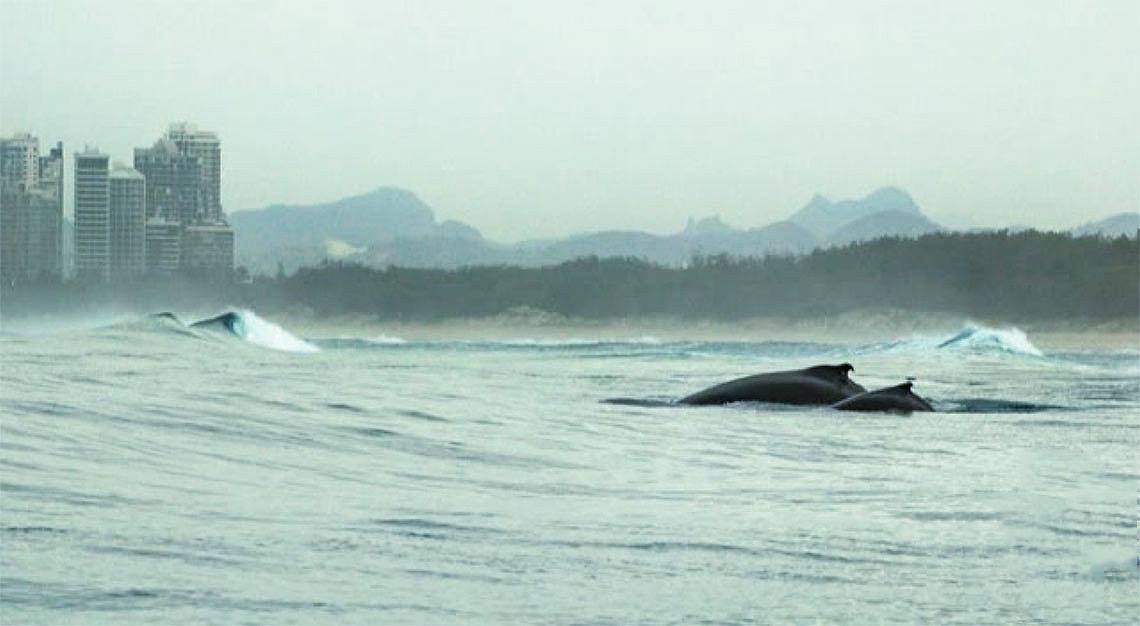
The most recent data available from the Department of Environment indicates that in 2008 whale watching tourism in Australia was worth $31 million in direct expenditure to the Australian economy, and that the number of tourists participating in whale watching has grown to over 1.6 million people per year and is estimated to grow by 10% per annum.
In 2016, data from Tourism and Events Queensland showed 164,000 domestic and 585,000 foreign visitors engaged in whale or dolphin watching in Queensland from March 2015 to March 2016.
https://boatgoldcoast.com.au/giving-back-to-the-whales/
Gold Coasters enjoying the natural beauty of the Seaway have enjoyed some amazing natural sights over the past few weeks.
On Monday 21 June 2006, a large adult Humpback whale was spotted in the area of the proposed cruise ship terminal construction zone, adjacent to the seawall in the Gold Coast Seaway.
Whale watchers tracked the whale up and down the Seaway as it swam and basked right in the proposed development site. They enjoyed this amazing experience up close for over three hours.
Two weeks previously, other whales were spotted in the Seaway. Gold Coast residents and tourists have enjoyed the spectacular performance that these whales put on in the waters just off the city every June and July as well as later September and October, in their migratory passage close to the mainland. But these latest sightings - by people on land within 5 metres of the whale - are quite simply extraordinary in the midst of a large city.
The presence of the whales is yet another reminder of the natural beauty and wonder of the Spit; something that no government and no developer has the right to take from the people.
In recent times, the waters off the Gold Coast's beaches have increasingly become a birthing site and nursery for migrating humpback whales.
ABC: Humpback Whales Birthing Off Gold Coast
Humpbacks & High-Rises (HHR) is running South East Queensland's largest whale and dolphin monitoring program. They are looking after thousands of whales and dolphins in the region. Founded in 2011 on the Gold Coast by Dr Olaf Meynecke, surveys are currently being undertaken in the Gold Coast Bay, Moreton Bay, and soon the Sunshine Coast.
Film Industry
The Gold Coast is the major film production centre in Queensland and has accounted for 75% of all film production in Queensland since the 1990s, with an average minimum expenditure of approximately $150 million per year. The Gold Coast is the third largest film production centre in Australia behind Sydney and Melbourne.
It is beyond the scope of this article to go into details regarding the positive economic, jobs and tourism outcomes of the Gold Coast film industry.
However, it has been stated consistently by the international and local production companies that have shot films, television and commercials on the Gold Coast that it is:
the temperate climate and the availability and close proximity to the mountains, rainforests, beaches, ocean, natural settings, parks, waterways, islands and dive, surf, fishing and boating locations, in addition to the city skyline and film studios, that makes the Gold Coast such a desirable film location for a whole range of films from Scooby Doo (2002) to Pirates of the Caribbean (2017) and Dora the Explorer (2019).
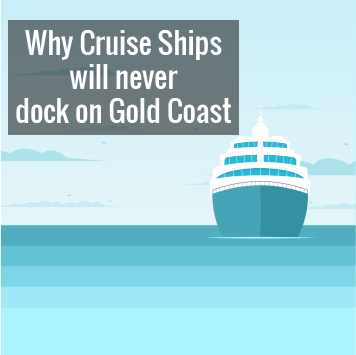 advanced search tips
advanced search tips
Other Articles
Oct 4, 2025 Shock Plans Uncovered for Wavebreak Island »
Nov 22, 2024 Hidden Beach Bar Report exposed »
Jun 17, 2024 Beach Bars - Community Reponse Required »
Jan 22, 2024 The 'forces of darkness' still active »
Jul 27, 2023 Australian Bush Medicine »
Mar 10, 2023 Council & State Attempt to Trash Spit Master Plan »
Dec 24, 2022 Drawing a Line in the Sand (Dunes) »
Mar 21, 2022 Australia's Best Beaches »
Nov 16, 2021 Foreign company given our beach for free »
Oct 14, 2021 Beach Bar Trial - All Splash No Substance »
May 6, 2021 Dunes - Nature's way of defending the coast »
Jun 26, 2020 AGM 2020 »
Jun 3, 2020 Tourism Gold Coast - part 3 »
Jan 13, 2020 Tourism Gold Coast - part 2 »
Dec 16, 2019 AIR POLLUTION - Beyond the Haze »
Dec 4, 2019 Casino Report - Bias, Omission and Error »
Sep 4, 2019 THE DOG who finally caught the car! »
Mar 14, 2019 SOS analysis of draft Spit Master Plan »
Feb 22, 2019 CHINATOWN »
Sep 25, 2018 A Critical Analysis of the Second Casino Licence »
Aug 13, 2018 CST Attempt #15 Tugun Farce »
Aug 11, 2018 New 'Research Queen' to head Destination GC »
May 30, 2018 Regional Excellence Award - Winners »
May 14, 2018 Gold Coast Cruise Ship Terminal »
Apr 24, 2018 The Games are Over »
Jan 27, 2018 Spit Master Plan process has begun »
Dec 18, 2017 Spit Upgrades Launch »
Nov 24, 2017 Developer Donations Buying Favours and Influence »
Nov 22, 2017 Why we cannot trust them with Our Spit »
Nov 14, 2017 Supporting those who support us »
Oct 27, 2017 Bill for CST investigations could reach $12.5m »
Oct 7, 2017 In any other State but Queensland »
Sep 15, 2017 ABC 4 Corners probe GCCC re donations »
Aug 1, 2017 You Won - Spit Casino Cancelled »
Jul 31, 2017 SOSA AGM Monday 7th Aug »
Jul 5, 2017 Feasibility Study Costs »
Jun 6, 2017 Election promises? Not worth a cent! »
May 9, 2017 Silent Minority Exposed »
Apr 27, 2017 Collective Amnesia at CCC Hearing »
Apr 6, 2017 Light Rail loop-hole »
Mar 22, 2017 Consultation Sunday 26th 10:30 am »
Mar 10, 2017 Australian: ASF Financial Viability Woes »
Mar 8, 2017 Big Public Info Night Thurs 9th 6pm »
Feb 26, 2017 Has Lynham done secret deals with Tate? »
Feb 11, 2017 So again nothing new here Tom »
Feb 9, 2017 Survey Does Not Stack Up »
Feb 8, 2017 Warning new group compromised »
Jan 25, 2017 Napkin sketches and a dot point list »
Jan 19, 2017 Have you been consulted? »
Dec 20, 2016 Appealing Attractions - Casino ranked last »
Nov 26, 2016 Four Levels of Corruption »
Oct 8, 2016 A Murky Week in Gold Coast Politics »
Sep 6, 2016 Sunday Mail Casino Debacle »
Aug 27, 2016 Sunland Absurdity »
Aug 19, 2016 AGM Monday 22 6PM »
Jul 29, 2016 The State of Play »
Mar 17, 2016 Change is in the Air »
Feb 4, 2016 Rally in the Park Chevron Is Sunday »
Jan 31, 2016 The Elected Obfuscators Bluff »
Dec 20, 2015 A Christmas Message »
Nov 2, 2015 Peter Garrett re Cruise Ships »
Oct 15, 2015 Last chance to lodge your objection »
Oct 2, 2015 Back to the 1980s »
Sep 5, 2015 Broadwater and Spit Masterplan »
Aug 29, 2015 How to Report Potential Official Misconduct »
Jul 13, 2015 XCAT Farce Paradise Lost and more »
Jun 11, 2015 GCCC under review »
Jun 6, 2015 Another Radical Private Development »
Jun 1, 2015 My fun is more important than yours »
Apr 29, 2015 Economic Fear Campaign »
Mar 26, 2015 Reflections on the Water »
Feb 16, 2015 Project Terminal »
Feb 2, 2015 Election Result Sinks Gold Coast Terminal »
Jan 16, 2015 Tell the Truth - Public Meeting »
Dec 25, 2014 And so this is Christmas »
Dec 24, 2014 Seeney not winning friends on Coast »
Dec 19, 2014 The Numbers don't Lie »
Nov 21, 2014 Save our Spit Photographic and Art Show »
Nov 15, 2014 Senate Inquiry »
Nov 3, 2014 Grand Theft Wavebreak public rally »
Oct 23, 2014 Cronyism Exposed Again »
Oct 6, 2014 Greywater »
Sep 20, 2014 Expert Against Coast CST »
Sep 4, 2014 3 Events to attend »
Aug 30, 2014 Deputy Premiers Announcement »
Aug 23, 2014 The Hidden VDM report »
Jul 26, 2014 Politics and Rumours »
Jun 6, 2014 A call to action »
May 3, 2014 Move over Julia »
Apr 30, 2014 Just suck it up and say NO! »
Apr 25, 2014 That is not consultation »
Apr 8, 2014 Full Page Newspaper Propaganda Ads Begin »
Apr 5, 2014 Report revealed »
Apr 1, 2014 April Fools Day with flawed survey »
Mar 24, 2014 Questions our GC Councillors must ask ASF »
Mar 14, 2014 Hey small spender »
Feb 24, 2014 Surf threatened by CST »
Feb 19, 2014 Tate considers quitting »
Feb 14, 2014 Live blog with Mayor Tom Tate »
Feb 14, 2014 Gration for Mayor 2016 »
Feb 5, 2014 Currumbin under threat from dredging »
Jan 28, 2014 What is a SLAPP Suit? »
Jan 15, 2014 It's a whole of city issue »
Jan 1, 2014 Cowards Lies and China Syndrome »
Dec 30, 2013 North Kirra Cruise Ship Terminal »
Dec 30, 2013 Mick Fanning speaks out on Kirra CST »
Dec 14, 2013 Councillors unaware of Brisbane CST »
Nov 29, 2013 Grand Theft Land »
Nov 16, 2013 The Hidden Urbis Report »
Oct 24, 2013 2013 Gold Coast Media Awards »
Oct 21, 2013 State vs State vs Mate »
Oct 19, 2013 What actually happened at the vote »
Oct 18, 2013 Dear Councillor »
Sep 12, 2013 Ship visits raise concern »
Sep 6, 2013 Vote 1 Save Our Spit »
Aug 24, 2013 Mayor Plays the victim »
Aug 24, 2013 Cruise Industry Forum Cancelled »
Aug 14, 2013 Secret Study values Broadwater at $4.1 b »
Aug 10, 2013 AGM 2012-13 Sep 10 7pm »
Aug 10, 2013 CST Bidder pulls out »
Jun 23, 2013 Cruise Ship Terminal in doubt »
Jun 6, 2013 Q and A info Night »
May 29, 2013 Joel cans Terminal idea »
May 22, 2013 AECgroup Business Case Analysis »
Apr 22, 2013 CMC probe into Oceanway »
Apr 14, 2013 Secret letters and meetings »
Apr 8, 2013 CMC under LNP attack »
Apr 4, 2013 Golden myopia »
Mar 16, 2013 Green Sea Turtle May have paid Price »
Mar 9, 2013 Golden Opportunity Missed »
Mar 6, 2013 Controlled Messaging Fails »
Mar 4, 2013 Open for Business »
Mar 2, 2013 Gambling with our coastline »
Feb 17, 2013 Gold Coast Waterways Authority Appointees »
Feb 9, 2013 Expressions of Interest Broadwater Marine Project »
Feb 2, 2013 Analysis of the navigational report 2012 »
Jan 26, 2013 Survey Called into Question »
Jan 19, 2013 Light Rail court battle with Council »
Dec 18, 2012 Bob Katter makes it a Federal issue »
Dec 18, 2012 Self-interest rather than vision »
Dec 13, 2012 A history lesson »
Dec 13, 2012 Land grab confirmed by report »
Dec 12, 2012 Community Information Session 10AM Thurs 13th »
Dec 6, 2012 Selling off our public land and water! »
Dec 5, 2012 Shoals vital to quality waves at Strad »
Dec 3, 2012 A bad week and month for LNP »
Nov 29, 2012 The unethical removal of Dr Alex Douglas »
Nov 25, 2012 No one voted for this »
Nov 13, 2012 Annastacia stands up for the community »
Nov 10, 2012 Father Son »
Nov 10, 2012 The Younger Generation Get It »
Nov 6, 2012 Rally gets Australia wide attention »
Nov 3, 2012 RIP Angus »
Oct 27, 2012 Ignored Tax and Rate payer »
Oct 27, 2012 Broadwater water quality degrading »
Oct 27, 2012 In Union there is strength »
Oct 20, 2012 Leadership not spin »
Oct 16, 2012 Comparing apples with apples »
Oct 12, 2012 Not the Panacea of Gold Coast Economic Woes »
Oct 8, 2012 Divide and Conquer - Trade Off »
Oct 5, 2012 Dawny lets us down »
Oct 3, 2012 Joel Parkinson - thanks »
Oct 2, 2012 Thanks for the support Occy »
Oct 1, 2012 Free Like Me »
Oct 1, 2012 Gold Coast Bulletin backs the people »
Sep 23, 2012 Sembawang disappears into a puff of logic »
Sep 21, 2012 Thanks for the support Kelly »
Sep 19, 2012 Mick Fanning is a legend »
Sep 11, 2012 Ship Terminal Sembawang Wave Break Survey »
Sep 3, 2012 No support for Sembawang Proposal »
Sep 3, 2012 A letter to the Premier »
Aug 28, 2012 Russ Hinze changed his mind 1980 »
Aug 22, 2012 Facebook saving our spit »
Aug 21, 2012 Is the Spit Man Made? »
Aug 14, 2012 The qu is NOT where but WHY? »
Aug 2, 2012 Lose Kirra or Straddie »
Jul 27, 2012 Hello SGC Business Leaders »
Jul 23, 2012 Cruise Ship Terminal - White Elephant »
Jul 17, 2012 Dear Mr Tate »
Jul 9, 2012 City Backs Terminal - NOT »
Jun 22, 2012 Join Us »
Jun 22, 2012 Public Open Space »
Jun 12, 2012 AGM 2011-12 Thurs 21 June 7 pm »
Jun 8, 2012 Dear Mayor and Councillors »
May 31, 2012 A Casino spitting ships »
Apr 26, 2012 Not printed in the local paper »
Mar 3, 2012 Kelly Slater video helps SOSA »
Feb 22, 2012 Broadwater Community Reference Group »
Jan 16, 2012 Cruise Mishap a reminder to us »
Sep 29, 2011 Broadwater Management Plan »
Jun 11, 2011 AGM 2011 Wed 13th »
Oct 22, 2010 Cruise Ship Tourists may not spend »
Aug 31, 2010 Another Broadwater plan »
Jul 20, 2010 Gold Coast Bulletin Frenzy »
Jul 14, 2010 A supporters spit »
Apr 29, 2010 AGM 2010 Tues 18 th May »
Nov 26, 2009 Rich dumping filth in our Broadwater »
Sep 14, 2009 ITU World Triathlon great for Gold Coast »
Sep 1, 2009 letter - Dead section of the Spit »
May 25, 2009 President has a SPIT »
May 13, 2009 AGM 2009 Wed May 27th 6-8 pm »
Apr 24, 2009 Medico supports SOSA »
Apr 1, 2009 Tides of Change - Have your say »
Mar 17, 2009 Navigational Study No Secret »
Feb 25, 2009 News Beatups »
Jan 11, 2009 Safely sharing the seaway »
Oct 24, 2008 Catalyst - invasive species by boat »
Oct 4, 2008 Save Our Spit Stickers Available »
Sep 22, 2008 Government Architect Mr Philip Follent »
Sep 10, 2008 Straddie saved from Receding Hairline »
Sep 4, 2008 Terminal Politicians »
Jul 4, 2008 Terminal terminated so Move On »
May 28, 2008 The Good, The Bad & the Ugly »
May 14, 2008 Oceanway Pathway debacle »
May 14, 2008 GCCC Bulldozes Spit Dunes »
Apr 19, 2008 Celebrate a few victories »
Mar 16, 2008 Domestic visitors spend $3 b on Gold Coast »
Mar 11, 2008 Council Election 2008 »
Jan 8, 2008 Christmas Greeting 2007 »
Jan 2, 2008 Letter to John Mickell MP »
Nov 21, 2007 Friends of Federation Walk new website »
Sep 26, 2007 Paul Lucas pushing Marine Simulator »
Aug 6, 2007 Developers on notice re Local Area Plan »
Aug 4, 2007 Protection for the Gold Coast Spit at last! »
Aug 4, 2007 Premier Beattie Saves Our Spit »
Jul 18, 2007 Spit Training Centre Threat »
May 18, 2007 Lessons from Los Angeles »
Apr 25, 2007 Another Storm for the Spit »
Apr 16, 2007 State Government Threatens Spitů Again »
Apr 13, 2007 Gold Medal Winner and the Spit »
Mar 27, 2007 Sean's letter »
Feb 23, 2007 Sea World Ferris Wheel Fiasco »
Jan 29, 2007 Reignited Protests »
Jan 19, 2007 Financial Review Article - Millionnaire Greenies »
Nov 17, 2006 Beach Spirit Award Winners - The Spit »
Nov 14, 2006 Cruise liner dumps oil in Paradise »
Nov 11, 2006 Developer 'Vision' Not 20:20, say Spitfighters »
Nov 9, 2006 Government plans for future Spit vision: Bligh »
Oct 13, 2006 What a difference 48 hours makes »
Sep 10, 2006 Government Speak »
Sep 10, 2006 Boating Industry views »
Aug 28, 2006 Super Yachts OK- in the Right Place »
Aug 11, 2006 The SpitFight Goes To Canberra »
Aug 5, 2006 Gold Coast Bully - Taken to Task »
Jul 14, 2006 Natural tourism drawcard threatened - Alan Midwood »
Jun 25, 2006 Greatest City Dive at Risk »
Jun 22, 2006 Whales Spotted in Proposed Terminal Site »
Jun 13, 2006 Our letters sent to Peter Beattie via Peter Lawlor »
Jun 11, 2006 Peta-Kaye Croft ignores her constituents on SOS »
Jun 1, 2006 Letter to Gold Coast Bulletin - I am not a Green »
May 31, 2006 A letter to Anna Bligh from Gecko »
May 31, 2006 Spitfighters Fight Back - Life Weekly article »
May 27, 2006 Sailing into murky waters »
May 20, 2006 Life Weekly Magazine article »
May 10, 2006 Gold Coast City Marina - Exposed »
May 3, 2006 Athletes fight to Save their training ground »
Apr 22, 2006 Notional Shipping Terminal Confirms Public Losses »
Apr 21, 2006 Save Our Spit- from Strength to Strength »
Apr 21, 2006 Overseas Cruise Ship Campaigners »
Apr 2, 2006 Gaven - Ominous warning to the Beattie Government »
Mar 30, 2006 What the Gaven by-Election Candidates said »
Mar 23, 2006 Gaven by-Election Media Release »
Mar 19, 2006 Peter Beattie meets SOSA at Robina »
Mar 12, 2006 An historical journey »
Mar 5, 2006 Surf cola »
Mar 5, 2006 Storm surf breaks across Seaway »
Feb 21, 2006 Labor 'greed' on tunnel fiasco - sounds familiar »
Feb 19, 2006 Surf Rage »
Feb 17, 2006 Surfrider - media release »
Feb 13, 2006 Gold Coast - too good for a shipping terminal »
Feb 13, 2006 Peter Beattie and co's dancing figures »
Feb 8, 2006 Master Mariner questions sanity of proposal »
Feb 5, 2006 Surfers promise to wipe out Labor »
Feb 5, 2006 Councillor Susie Douglas's inspiring rally speech »
Feb 3, 2006 Letters to the 'Bully' »
Jan 25, 2006 Surfrider says »
Jan 24, 2006 Pro Terminal threaten to attend rally »
Jan 12, 2006 Public Rally Feb 5th 12 noon »
Jan 11, 2006 Anna Bligh confirms it's not a done deal »
Jan 9, 2006 Who Murdered Mundaka - is Straddie next? »
Dec 21, 2005 MP's Ciobo and Langbroek not happy »
Dec 16, 2005 Ms Levy's band of do-gooders »
Nov 28, 2005 A new Picture - future Spit »
Nov 23, 2005 Anna Bligh and misinformation »
Nov 11, 2005 Bulletin gone quiet »
Nov 5, 2005 Surfrider Foundation's support »
Nov 5, 2005 US Forces get the nod »
Nov 1, 2005 The Global War on Tourism »
Oct 25, 2005 Are Cruise Ships getting too big? »
Oct 14, 2005 Meeting Tuesday 18th October SOS »
Oct 13, 2005 Brad Farmers Message - Letter to the editor »
Oct 11, 2005 A very personal attachment to the Spit »
Oct 10, 2005 Map - SOS opposition to Government Plans »
Oct 7, 2005 Increased Cancer Risk From LA Port Complex Fumes »
Oct 6, 2005 From Strength to Strength in our campaign »
Sep 28, 2005 Venice Sinking under cruise ships »
Sep 21, 2005 Thats not reality but this is »
Sep 18, 2005 EIS rubber stamp? »
Sep 5, 2005 Letter to Bulletin »
Aug 29, 2005 Excerpts: »
Aug 28, 2005 Plans for lakes of effluent on Straddie !!! »
Aug 23, 2005 Not Exactly The Love Boat - New Book »
Aug 3, 2005 Premier sinking Gold Coast dive industry »
Aug 2, 2005 Thumbs up for Councillor Susie Douglas »
Aug 1, 2005 World Class Waves at Risk »
Jul 18, 2005 New Stickers Available »
Jul 18, 2005 Save our spit campaign highlights »
Jul 18, 2005 People and Parks Day Sunday 31st July »
Apr 20, 2005 Trinity Lutheran College Cruise Ship Debate »


